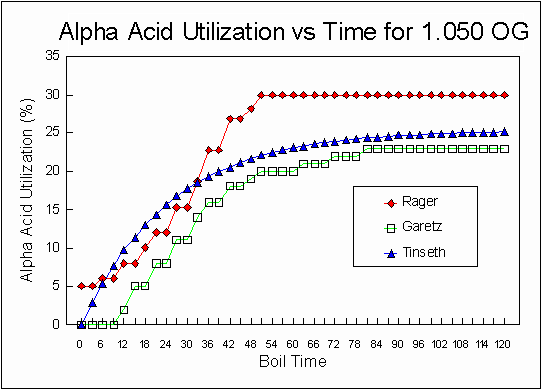This week I take a look at the three major hop utilization models: Tinseth, Garetz, and Rager used to calculate bitterness in beer brewing.
Bitterness Levels and IBUs
The bitterness of a beer contributed by hops in the boil is typically estimated using one of three major hop utilization equations. All three attempt to estimate the bitterness as measured in International Bitterness Units (IBUs). One IBU roughly represents a mg/L of isomerized alpha acids in the wort, though in practice IBUs are measured using light.
As I covered in a separate article, these three equations estimate the bitterness levels in the wort at the end of the boil. As substantial alpha acids are lost in fermentation, packaging and aging, the measured bitterness level in the finished beer will likely be much lower than the estimates provided here. However, by convention brewers use these estimates to characterize the IBU level for a given style and the estimate is also often used to specify relative finished beer bitterness levels.
The Bitterness Equation
All three models use the same equation for the basic IBU estimate. They differ only in how they calculate the utilization factor UTILIZATION below:
IBUs = (UTILIZATION * ALPHA_ACID_PCT * WT_OZ * 0.7489) / VOL_GAL
The ALPHA_ACID_PCT is the percent alpha acid content in the hops, WEIGHT_OZ is the weight in ounces, VOL_GAL is the volume in gallons and UTILIZATION is the utilization factor which varies depending on the equation used.
The most popular of the three equations is the Tinseth equation derived by Glenn Tinseth. His equation simply calculates the utilization as a product of a time factor and a wort gravity factor. The time factor is (1.0 – exp( -0.04 * boil_time )) / 4.15 and the gravity adjustment is 1.65 * pow( 0.000125, (SG – 1.0 )), So utilization falls with hop gravity, but increases with boil time. The other equations are similar – using a combination of boil time and boil gravity to estimate the utilization.
It is probably best to consider the three equations graphically shown in the image at the top of this article. Garetz and Tinseth match up fairly well for longer boil times, though Garetz treats boil times below 10 minutes as having a utilization of zero, which is probably not realistic. In contrast Rager estimates substantially higher utilization for all boil times above about 18 minutes.
Rager was once popular with many extract brewers, though I think it tends to produce hop utilization numbers that are on the high side. Garetz matches up well but does not work as well for small boil times, which can be a problem for short boil hops as well as in many whirlpool conditions where these same models are applied to determine whirlpool isomerization. Overall Tinseth has become the standard for most brewers as it is continuous throughout the boil period and provides a reasonable estimate in a variety of conditions.
I hope you enjoyed this week’s article from the BeerSmith Home Brewing Blog. Please subscribe for regular weekly delivery, and don’t hesitate to leave a comment or send this article to a friend.

What are your thoughts on Paul-John Hosom’s mIBU (Maximum IBU) calculations? I used it with a recent brew and I’m still waiting on the results.